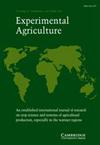休耕除草通过改变氮素吸收来改变水稻产量
IF 1.9
4区 农林科学
Q1 Agricultural and Biological Sciences
引用次数: 0
摘要
休耕杂草可以在不需要任何投入的情况下在稻田中大量生长,并提供与覆盖作物类似的生态系统服务,如减少氮淋失和捕获碳。因此,允许休耕杂草生长是水稻种植系统中覆盖作物的潜在替代方案。为了评估该策略的可行性,需要明确休耕杂草对水稻产量的影响。在这项研究中,进行了为期2年的田间试验,比较了施用和未施用休耕杂草(500 g m−2,晒干)的水稻对氮的吸收、生物量生产、产量组成部分和籽粒产量。结果表明:在水稻生长早期(移栽至分蘖中期),施用休耕杂草可使水稻地上部氮素吸收和生物量产量降低21 ~ 30%;然而,这些减少并没有导致粮食产量的减少,因为在生育中后期(从穗萌发到成熟),地上氮素吸收和生物量生产的增加弥补了这些减少,甚至超过了这些减少。此外,休耕杂草的施用使水稻穗粒数增加了6-7%。这些结果为休耕杂草可能改变水稻产量形成提供了初步证据,并强调需要进一步研究休耕杂草对水稻氮吸收影响的生态生理机制。本文章由计算机程序翻译,如有差异,请以英文原文为准。
Fallow weed application alters rice yield by changing nitrogen uptake
Summary Fallow weeds can be abundant in rice paddies without any inputs and provide ecosystem services like those of cover crops, such as reducing nitrogen (N) leaching and capturing carbon. Therefore, allowing fallow weeds to grow is a potential alternative to cover crops in rice cropping systems. To evaluate the feasibility of this strategy, the effect of fallow weeds on grain yield in rice needs to be clarified. In this study, 2-year field experiments were conducted to compare N uptake, biomass production, yield components, and grain yield in rice with and without application of fallow weeds (500 g m−2 , sun-dried). Results showed that the application of fallow weeds reduced aboveground N uptake and biomass production by 21–30% during the early growth period (from transplanting to mid-tillering) in rice. However, these reductions did not lead to reduced grain yield because they were compensated for or even exceeded by increased aboveground N uptake and biomass production during the middle and late growth periods (from panicle initiation to maturity). In addition, the application of fallow weeds increased spikelets per panicle in rice by 6–7%. These results provide preliminary evidence that fallow weeds may alter yield formation in rice and highlight the need for further investigations of the ecophysiological mechanism underlying the effect of fallow weeds on N uptake in rice.
求助全文
通过发布文献求助,成功后即可免费获取论文全文。
去求助
来源期刊

Experimental Agriculture
农林科学-农艺学
CiteScore
2.50
自引率
6.20%
发文量
29
审稿时长
24 months
期刊介绍:
With a focus on the tropical and sub-tropical regions of the world, Experimental Agriculture publishes the results of original research on field, plantation and herbage crops grown for food or feed, or for industrial purposes, and on farming systems, including livestock and people. It reports experimental work designed to explain how crops respond to the environment in biological and physical terms, and on the social and economic issues that may influence the uptake of the results of research by policy makers and farmers, including the role of institutions and partnerships in delivering impact. The journal also publishes accounts and critical discussions of new quantitative and qualitative methods in agricultural and ecosystems research, and of contemporary issues arising in countries where agricultural production needs to develop rapidly. There is a regular book review section and occasional, often invited, reviews of research.
 求助内容:
求助内容: 应助结果提醒方式:
应助结果提醒方式:


